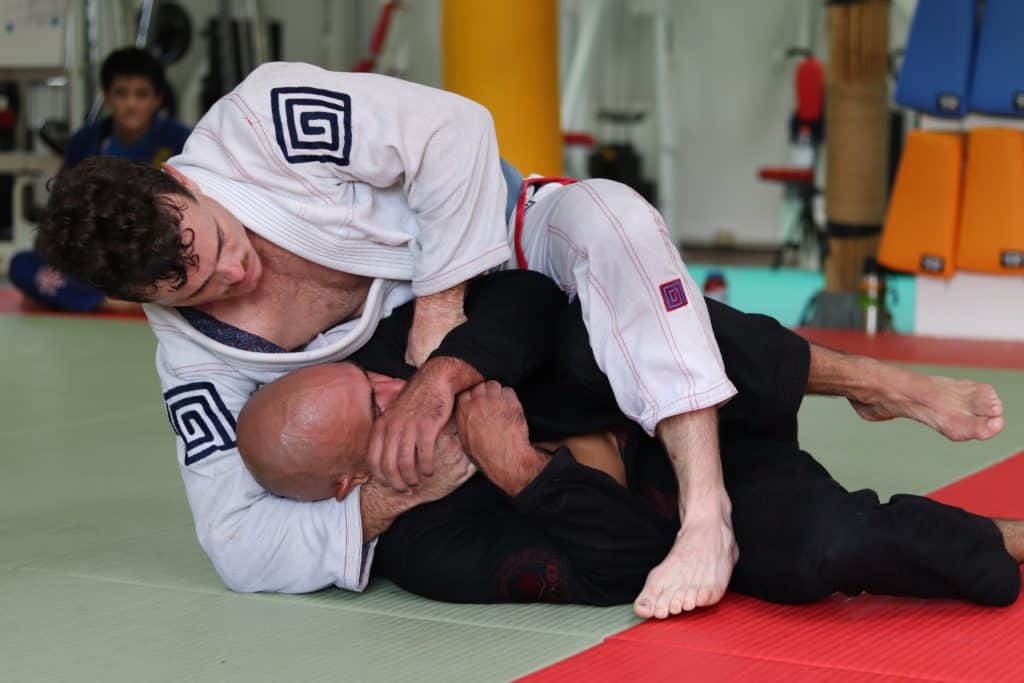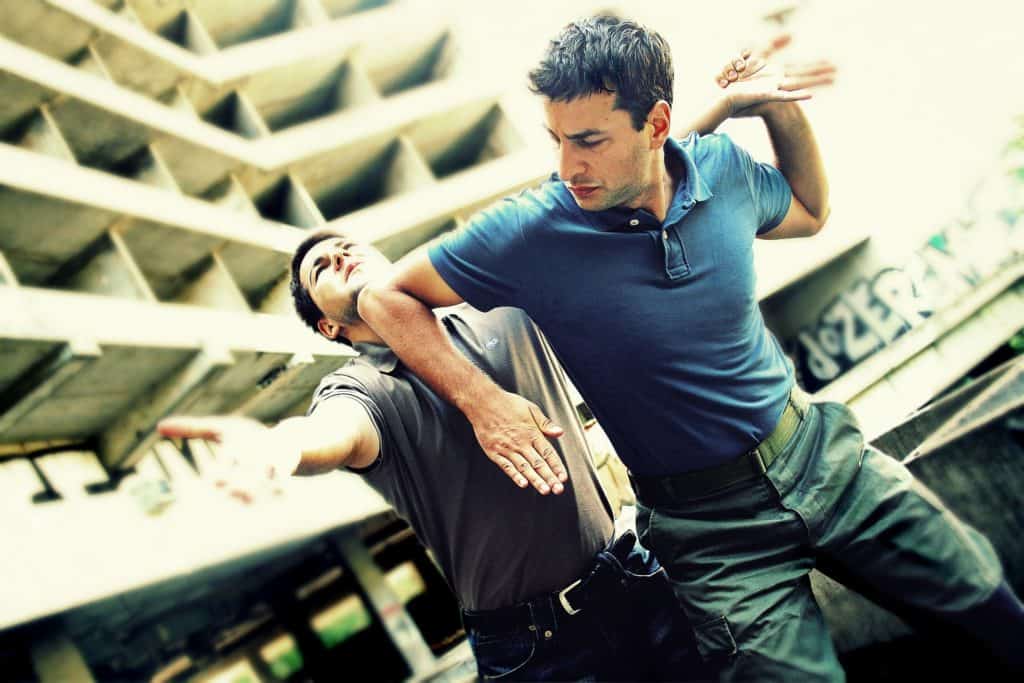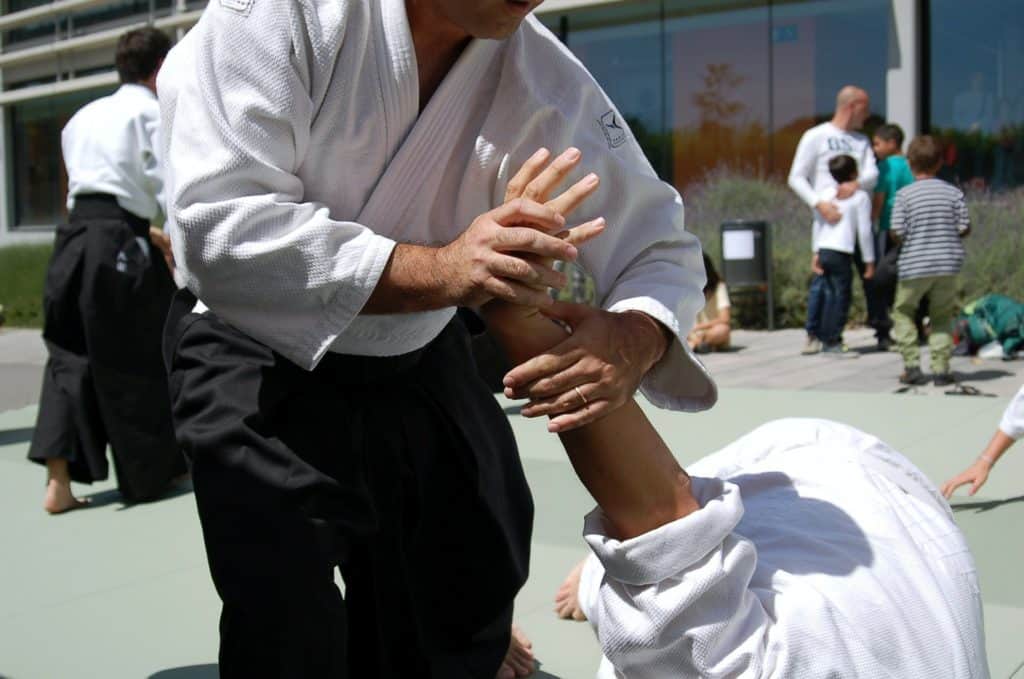
If you’re looking to join martial arts for your fitness, spiritual harmony or to hone your mind and body, picking the right martial arts style is essential if you’re going to enjoy yourself.
Because the world of martial arts is so diverse with so many different styles of martial arts out there, choosing a martial arts style can be a mind-boggling undertaking.
To help you navigate through the different Martial Art types and make sense of which is right for you (or your kids), I’ve listed the top 12 most popular types of Martial Arts, in no particular order, with a brief explanation of each one.
1. Karate

This is a type of martial arts that originated from Okinawa, Japan in the early 20th century and is one of the most popular styles. Karate is, more than anything else, centered on self-defense and self-discipline.
It revolves around powerful punches, kicks, open hand strikes, blocks, as well as the use of elbows and knees. However, learners are generally taught to prevent and stop attacks rather than going on the offensive.
Karate is sometimes referred to as the art of the “empty hand” as it rose to popularity in Japan at a time when weapons were outlawed in the country. This style has taken to the philosophy of yoga and other Japanese physical practices.
That’s why it has gone beyond the movie studios to become part of everyday life. It encourages practitioners to adhere to the principles of respect, discipline, and the relentless pursuit of improvement.
For a Comparison between Karate and TaeKwonDo, check out this article I wrote.
2. Jujitsu (Jujutsu, Jiu-Jitsu)

With famous adherents such as Jessica Alba, Ice T, and Ryan Phillipe, Jujitsu is another popular Japanese martial arts style. Unlike karate that involves lots of powerful kicks and punches, Jujitsu mostly incorporates a wide range of chokes, pins, locks, holds, and joint manipulations.
Instead of directly defending attacks through blocks (as with most martial arts such as karate), Jujitsu mainly focuses on neutralizing the attacker. In most cases, a Jujitsu fighter redirects the attacker’s energy and momentum through the above-mentioned ways.
As a result, the Jujitsu fighter can easily render the attacker useless through calculated moves and joint locks; two combinations that make Jujitsu a very effective but also a deadly martial arts style. The most popular type of this style is the Brazilian Jujitsu, which focuses on joint locking and choking the opponent while fighting on the ground.
For a Comparison between Jujitsu and TaeKwonDo, check out this article I wrote.
3. Judo

Created in 1882, Judo is a relatively modern type of Japanese martial arts that doubles up as an Olympic sport. Like Jujitsu, Judo involves a lot of grappling maneuvers such as pins, joint locks, choke, stranglehold, and throws.
The idea here is to take down the opponent to the ground with the main intention of subduing or immobilizing them. In other words, this is a martial arts style that’s based on using your opponent’s strength to your advantage to overpower him/her.
While strikes, the use of weapons as well as thrusts by hands and feet are not allowed in either free practice or competition, they can be allowed in prearranged forms such as the Judo Kata.
4. Kung Fu

Although Kung Fu has been in existence since the 1st Century, it became hugely popular, especially in the western world largely thanks to a certain Bruce Lee. It’s fundamentally an umbrella name that refers to a range of Chinese martial arts styles and techniques that helps in strengthening and balancing the body and mind.
Having originated in the Chinese Buddhist monasteries and Shaolin Temples around 500 CE, Kung Fu is a self-defense practice that incorporates graceful and flowing movements.
In addition to kicks, open and closed-hand strikes and blocks, Kung Fu also integrates agile reflexes, cardiovascular fitness, strategies, and the ability to read your opponent’s mind.
Most Kung Fu variations such as the Praying Mantis, Hung Gar, Wing Chun draw inspiration from Chinese religions, philosophies, legends, and various animal movements.
For a Comparison between Kung Fu and TaeKwonDo, check out this article I wrote.
5. Krav Maga

Krav Maga is a Hebrew phrase that loosely translates to “Battle Combat”. Developed in the 1930s in Israel, this is a martial arts style that teaches you a tactical system of preventing and handling violent attacks by any means necessary.
Although it involves grappling, wrestling and the use of hand strikes, Krav Maga encourages the practitioner to use virtually any object in the vicinity to defeat the attacker.
In essence, Krav Maga has no rules, no etiquette, no fighting pattern, and the practitioner can use anything to incapacitate or defeat the opponent.
That being said, Krav Maga is the official combat style of the Israel Defense Forces. It’s a technique that’s largely used in real-world scenarios such as in fighting anti-terrorism or by air marshals, special commando units, and other law enforcement agencies.
6. TaeKwonDo

Like Judo, Taekwondo is the only other martial arts style that is also an Olympic sport. It’s a fighting style of Korean origin, which makes it the national sport of South Korea.
As one of the most popular martial arts styles, Taekwondo might be confused with Karate even though they’re quite different. Unlike Karate that involves a lot of fists, Taekwondo emphasizes chiefly on powerful kicking techniques.
Although Taekwondo is one of the oldest forms of self-defense and martial arts styles, it has become more of a fitness movement that integrates various aspects of life skills such as discipline, respect, and personal strength. That’s not all; it also involves speed, balance, stamina, flexibility, and may include throws, take-downs, and joint locks.
7. Aikido

Favored by actor Steven Seagal in most of his movies, Aikido is a Japanese martial art style that doesn’t focus on kicking or punching the opponent. Instead, it teaches you to put a lot of emphasis on the safety and well-being of your opponent as much as you do your own. In other words, the main intention of an Aikido fighter is NOT to defeat the opponent but to find a peaceful resolution.
Aikido is perhaps the most spiritual martial arts style as it loosely translates to “the way of harmony of the spirit”. For this reason, an Aikido practitioner is always encouraged to use the opponent’s kinetic energy to take control of the situation and render the opponent powerless.
That’s why an Aikido practitioner uses fewer kicks and hand strikes and instead uses a lot of pushing movement, turning motions, and joint locks (but only when necessary).
8. Hapkido
This is another Korean martial arts style. It incorporates powerful kicks, punches, joint locks, throws, as well as strikes to various pressure points. Hapkido emphasizes on controlling and defeating the opponent through the use of non-resisting movements and circular movements.
This is principally why a Hapkido fighter uses intricate footwork and body positioning not just to gain control but also to elude the use of power against power.
While many people think that Hapkido and Aikido share similar principles (possibly because of the names), they are significantly different. For example, Hapkido can include the use of weapons such as cane, rope, and sword, albeit varyingly.
Needless to say, this is quite different from Aikido in terms of execution of techniques, range of response, and even the general philosophy.
For a Comparison between Hapkido and TaeKwonDo, check out this article I wrote.
9. Mixed Martial Arts (MMA)

Even though MMA is nowadays so popular thanks to fighters such as Conor McGregor, Khabib Nurmagomedov and others, MMA has been around for a very long time. Dating back to the Greco-Roman era, MMA has evolved to become a regulated full-contact combat sport with millions of fans around the world.
It involves fighting either while standing up or on the ground. A fighter can employ various techniques such as grappling, striking, choking, kicking, punching and many more. In essence, MMA incorporates various fighting techniques including submission, boxing, Jujitsu, Karate, Muay Thai, Judo and many more.
To see how MMA is integrated into TaeKwonDo, check out this article I wrote.
10. Muay Thai (Thai Boxing)

As the name suggests, Muay Thai is a martial arts style that has deep roots in Thailand and is the national sport of the Asian nation. And because the practitioner has to rely on eight points of contact (hands, elbows, knees, and shins), this style has been dubbed “the art of eight limbs”.
The style involves clinching techniques and stand-up striking. It requires the practitioner to convert different parts of his/her body into weapons of war. For instance, the hands can become swords and daggers, the knees can be used as an ax, the elbows can become hammers, the legs can turn into a staff while the shins and the forearms can be used as protective armor.
In essence, this martial arts style requires the use of both the lower and upper body, which essentially calls for a full-body workout as well as powerful core muscles.
For a Comparison between Muay Thai and TaeKwonDo, check out this article I wrote.
11. Tai Chi
With its roots in China, Tai Chi is a martial arts style that is not only practiced for its defense training but also its numerous health benefits (improving muscle strength, flexibility, cardiovascular fitness, better night sleep). This style generally involves elegantly choreographed slow-motion poses and positions.
Legend has it that Tai Chi’s slow-motion movements and postures are inspired by the slow movements of the crane bird fending off a snake in combination with the elegant movement of Taoist breathing practices. This is to enable you to relax, maintain an attitude of patience, and stay gently focused even when under the attack.
12. Capoeira

As the story goes, Capoeira is a type of Brazilian martial arts that was initially invented by Angolan slaves who wanted to hide their self-defense techniques as dance moves. This is why it involves constant dance moves, lots of music, endless movements, and, of course, fighting.
In its purest form, Capoeira involves two practitioners (known as Capoeiristas) surrounded by other participants in what is known as Capoeira wheel. Some of the participants must play percussion instruments to offer a thrilling musical background. And despite the rhythms, the fighters should use deception and maneuvers to confuse, control, and outwit the opponent.


